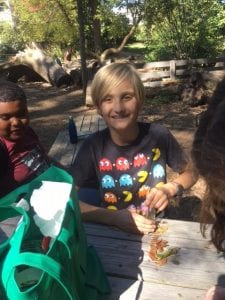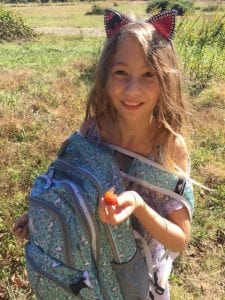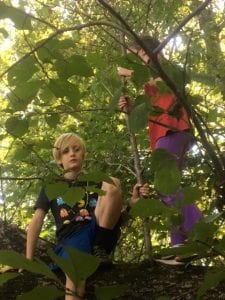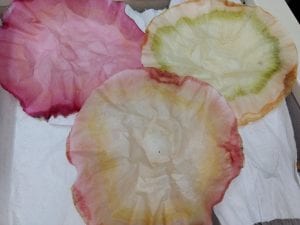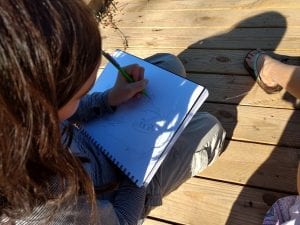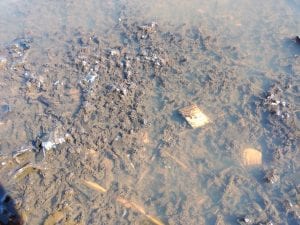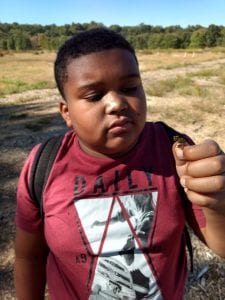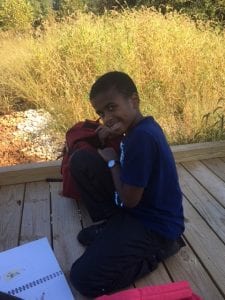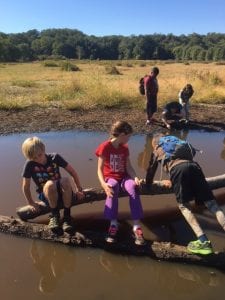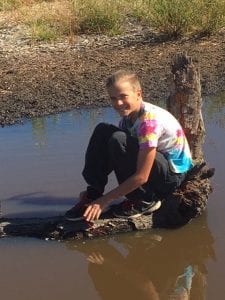Tuesday, October 3rd 2017
Where do leaves get their color? Why do they change color in the fall? What is chlorophyll and what does it do for a leaf? Those are some of the questions we asked at the beginning of class today. We also did a really fun art experiment using leaves in order to extract the pigments that gives leaves their color. Not only does it turn into a beautiful piece of art, it’s educational as well. While we waiting for all of our Earth Friends to arrive we set about the task of finding leaves of different colors from the forest floor. We gathered green leaves that were freshly fallen, red leaves, yellow leaves and leaves mixed with some brown. Taring the leaves into very tiny pieces we placed them into three cups. One of our cups was mostly red leaves, one was more green and yellow and one was a mixture of various colors. We poured in a little rubbing alcohol and set a coffee filter in and left it for the rest of class.
We hiked to the gazebo and had snack and did a second experiment while we munched down. This experiment also shows the power of capillary action. We spoke about this last class and today we tested it and saw real results! Below is an experiment we did with two jars filled with colored water (blue and yellow) and two pieces of paper towel linking the middle jar. In less than a minute you can see the water rise up the paper towel and down into the middle jar. In less than 5 minutes the water was turning green. This same scientific idea is what we’re using to make our chlorophyll art with coffee filters. Check that out later in the blog.
After eating and watching water defy gravity using water tension (another term we learned last week) we climbed a nearby tree and saw the forest from the view of a bird or squirrel. Climbing in nature is a great way to practice various motor skills, test balance and inspire self confidence and accomplishment. Climbing trees is great exercise and helps kids work and use different muscles than they would use just walked, playing games or even doing sports. Once we safely disembarked from the tree, we ran down the meadow to the pond we had explored on our first day. It was all dried up (as it usually is without any recent rain) and tried some of the wild persimmons in the meadow. Most of us tried them, Audrey really liked them and was going back for more! They’re only palatable when they’re ripe and the ripe ones are found on the ground. Lev crawled into the bushes and was collecting them in places the rest of us were hesitant to reach. Everyone tried them and almost all of us liked them. Some of us even tried the unripe ones (after I warned them they don’t taste very good) and they agreed, they were pretty bad.
Before exploring the pond, which is only partly full at the moment (pictured above) we played a few games in the shade. The first game we played is called Black Magic and it’s a riddle that I introduced last Fall with the homeschool students. Only two of them have heard the riddle before and were really excited to share it with the rest of the homeschoolers. Riddles like this one are a great way to have fun but also learn at the same time by using a challenging riddle to promote critical thinking and problem solving. So far, only the two (Henry and Solace) who heard it before know the answer. We also played a fun game called Earth Eyes. In this game you stand in a tight circle and look at the ground. When I say Eyes everyone looks up and looks at one person in the circle. If you make eye contact with another person who both are out. You play until only one person or one pair of people are left in the circle.
At the pond everyone immediately went for the log in the pond and started slowly crawling or walking across. On the log everyone got a close up look at the beetles in the water and saw frogs swimming away. The kids also discovered some strange red worms in the water and upon closer inspection we also noticed that they had created a lot of tubes in the mud! The worms also had these hair like appendages on them that they were likely using to filter out food from the pond. I also pointed out the water bubble on the beetles and we all soon saw how the bubble was attached to the back side of the beetle. These aquatic diving beetles don’t have gills so they aren’t able to breathe underwater, instead, they take a bubble of air under water with them like an oxygen tank. After some balancing and sitting on the long surrounded by water we explored the tall grass around the pond in the meadow and everyone created a game of hide and seek tag. The grass was so tall it was taller than all the kids and almost me and Mr. Dennis so it made a great spot for such a game.
After some tag and exploration we started to gather together on the bridge for journaling. Noa and Audrey started to journal about their experience at the pond. Noa drew people on the log in the pond! (See the pictures below in the gallery). Pretty soon we were all gathered on the bridge in the shade. We pulled out our journals and I introduced a new animal that has inspired some different types of innovation, mostly architecture. Those animals are bees. Honey bees are fascinating animals. Not only do they pollinate 70% of our food that we eat they have a very intricate way to communicate, the way they build their hives has stumped scientists and mathematicians for a long time. Why do they build their honeycombs in the shape of a hexagon. And not just any hexagon, it’s mathematically perfect, all sizes are identical. Not only that but a lot of bees work on the hive at the same time and yet they all seem to know exactly how to build the perfect hexagon. Here is an interesting and informative article about bees: http://www.npr.org/sections/krulwich/2013/05/13/183704091/what-is-it-about-bees-and-hexagons. We also explored some of the unique structures that have been inspired by bees. All of us pictured our favorite and glued it into our journal. A lot of people seemed to enjoy the tent camping set up the most! It’s a modular camping set up and they all fit together and are in the shape of hexagon tents.
Next week we’ll see the results of our chlorophyll experiment and talk about the different types of pigments we found in the coffee filters and answer those questions I posed at the beginning of the blog. Stay tuned for more exciting adventures!
- Henry working on our chlorophyll art
- Audrey trying the persimmons
- Climbing in the trees
- The results of our Chlorophyll experiment
- Journaling in the meadow
- The worm tubes in the pond
- Solace found an interesting seed top that I couldn’t identify
- Elias getting ready to journal
- Climbing on the log in the pond
- James sitting just above the water



